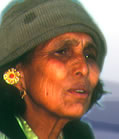THEMES IN THIS
TESTIMONY
Community Activities

Spiritual Beliefs

Water

Click on arrows
to find more
testimonies
featuring
these themes
|
|
Sex
|
male
|
|
|
Age
|
92
|
|
|
Identity
|
N
|
|
|
Occupation
|
|
|
|
Location
|
Sanagaon, Lalitpur
|
|
|
Date
|
1998
|
|
summary
This is one of the water testimonies of which we do not have a full transcript. It is the interviewer’s edited version of the testimony and does not include any questions top the narrator.
This testimony is a passionate lament about the decline in use and maintenance of village ponds. Yet although focusing on water and ponds in particular, this testimony covers wider issues, including social relations, communal work and spiritual beliefs.
A theme throughout the testimony is the different attitude between the older and younger generation: “In the old days, people used to clean the pond. But today, not everyone joins hands.” He goes on to say that “people have stopped appreciating the significance of these ponds. They should not be buried, they were built by our ancestors for use in emergencies, we said. But now one listened to us. Who listens to the aged?”
The cost of constructing a pond was, “borne by the donor. Because it was considered a pious act, all the people in the village helped dig and carry the soil. The benefactor provided free meals to everyone… the pond would be named after him.” Explains how “Similarly, as an act of piety, wells were excavated in the field.” The narrator exclaims, “Isn’t it a godly act to make water available to the thirsty?” He is disappointed that the present generation have “forgotten religion. All these ponds, wells and resting-places with provision for water have vanished because of the lack of faith. In our days we were scared to break or damage public facilities for fear of God. The children of today could not care less.”
The tone becomes more positive towards the end of the interview when the narrator talks about the cleaning of wells: “We do this once a year, and this practice continues till date.” He enthusiastically explains that water from one of the wells can cure goitre and how they let anyone from outside also use this water. He describes the construction of a well, but again reminds us of the difference today that “Now no one talks of digging a well.”
detailed breakdown
|
You will need a password from Panos to view the full
transcript of the interview. To apply for a password, click here.
Once you have a password, click here to go to the beginning
of the transcript. You can also click on any section of the
breakdown of content below and go straight to the
corresponding part of the transcript.
|
| Section 1 |
In the past ponds were built jointly by members of the community and .
filled with spring water or by a canal.
Appreciation of ponds has decreased: “With water available from taps these days, people couldn’t care less about the ponds… There were six ponds in this small village alone; four have vanished.”
|
| Section 2 |
Ponds were jointly constructed and owned: “Once the pond was constructed, you couldn't say his, mine, etc.”
Concern about where they will draw water from if there’s fire in the village, “Now with no water in the pond, we might have to carry water from the main canal.”
Guards are paid in kind by landowners to “ensure that there is a regular supply of water to the village” from the canal.
When ponds were cleaned out, the sediment was used as a rich fertiliser. People still clean ponds but the sediment is just dumped by the road etc.
|
| Section 3 |
Describes the careful construction of ponds in the past which was a pious act initiated by benefactors.
Passionate plea for maintaining the two remaining ponds
Conflict between the generations over the importance of the ponds.
|
| Section 4 |
Attributes loss of ponds to the availability of tap water but also to the “advent of democracy… People have started doing as they please. There is no hierarchy. There is no common courtesy and respect for old and senior citizens.” He goes on to complain that the young no longer respect caste differences.
He feels people’s modern day standard of living “is a mirage, a temporary illusion.”
The village wells are still very much in use for daily needs
|
| Section 5 |
“We clean these wells on a particular festive day every year. Everyone from the village joins hands to clean the wells.” After the well is cleaned the benefactor of the well draws the first water and offers it to the deities.
Water from the deepest well in the village is believed to cure goitre.
Courtesy shown to those who come from other villages to use the wells.
“We remember that the last well in this village was built some 20 years ago. Now no one talks of digging a well.”
Brief description of digging and preparing a well. |
|


